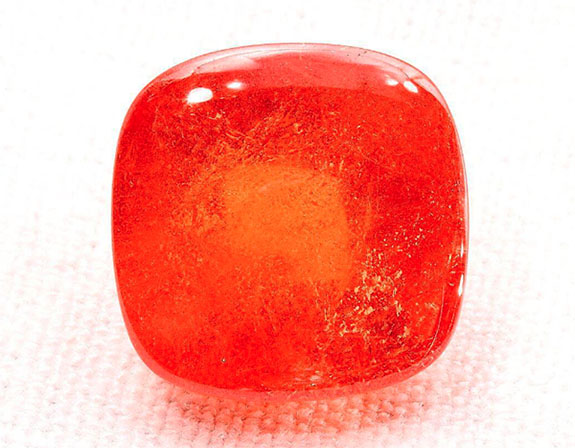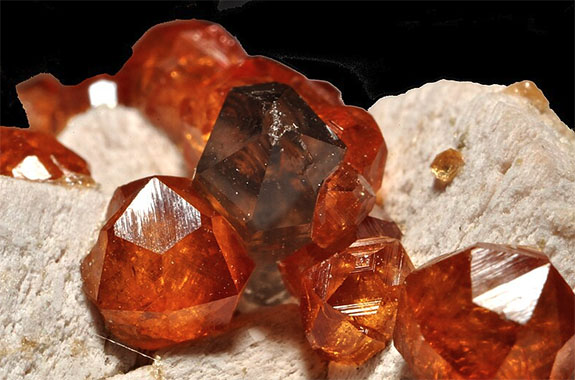January 3rd, 2024
Imbued with the hues of a summer sunset, spessartine garnets are the fiery orange variety of garnet, January's official birthstone. The wonderfully versatile garnet comes in a wide array of natural colors, including red, yellow, pink, purple, violet, green, black and brown.

The 19.77-carat spessartine garnet shown, above, is part of the Smithsonian's National Gem Collection and is housed in the National Museum of Natural History in Washington, DC. A gift from Edward W. Boehm in 2008, the specimen was sourced in Zambia and ranks as the finest spessartine in the collection.
Spessartine's orange color is attributed to its particularly high manganese content. The purest and most intensely orange varieties are often referred to as "mandarin garnets" and are mined primarily in Madagascar.
According to the International Colored Gemstone Association (ICA), the first mandarin garnets were discovered along the hilly border between Namibia and Angola back in 1991. Until then, spessartines had been found in other countries, but were favored by collectors and hardly used in jewelry. This is because specimens of excellent color and clarity were extremely rare.
But the crystals found in Namibia were, indeed, jewelry worthy. ICA states that the raw crystals quickly found their way into the cutting centers and onto the market. Within a short time, however, the mine was exhausted and production ground to a halt.

According to the Smithsonian, gem-quality spessartine comes mainly from Sri Lanka and Brazil, while other important localities include Australia, Burma, India, Israel, Madagascar, Zambia, Nigeria, Namibia and the US.
In addition to today’s featured spessartine garnets, other varieties often seen in jewelry include almandine, andradite, demantoid, grossularite, hessonite, rhodolite, tsavorite and uvarovite.
Garnets get their name from the Latin word “granatum,” meaning pomegranate seed. The beautifully red seeds of a pomegranate closely resemble rhodolite garnet.
Credits: Cabochon spessartine by Ken Larsen / Smithsonian. Spessartine crystals by Géry PARENT, Public domain, via Wikimedia Commons.

The 19.77-carat spessartine garnet shown, above, is part of the Smithsonian's National Gem Collection and is housed in the National Museum of Natural History in Washington, DC. A gift from Edward W. Boehm in 2008, the specimen was sourced in Zambia and ranks as the finest spessartine in the collection.
Spessartine's orange color is attributed to its particularly high manganese content. The purest and most intensely orange varieties are often referred to as "mandarin garnets" and are mined primarily in Madagascar.
According to the International Colored Gemstone Association (ICA), the first mandarin garnets were discovered along the hilly border between Namibia and Angola back in 1991. Until then, spessartines had been found in other countries, but were favored by collectors and hardly used in jewelry. This is because specimens of excellent color and clarity were extremely rare.
But the crystals found in Namibia were, indeed, jewelry worthy. ICA states that the raw crystals quickly found their way into the cutting centers and onto the market. Within a short time, however, the mine was exhausted and production ground to a halt.

According to the Smithsonian, gem-quality spessartine comes mainly from Sri Lanka and Brazil, while other important localities include Australia, Burma, India, Israel, Madagascar, Zambia, Nigeria, Namibia and the US.
In addition to today’s featured spessartine garnets, other varieties often seen in jewelry include almandine, andradite, demantoid, grossularite, hessonite, rhodolite, tsavorite and uvarovite.
Garnets get their name from the Latin word “granatum,” meaning pomegranate seed. The beautifully red seeds of a pomegranate closely resemble rhodolite garnet.
Credits: Cabochon spessartine by Ken Larsen / Smithsonian. Spessartine crystals by Géry PARENT, Public domain, via Wikimedia Commons.


